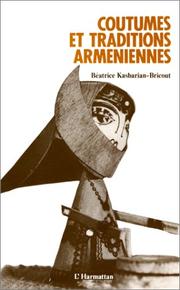| Listing 1 - 10 of 318 | << page >> |
Sort by
|
Book
Year: 1990 Publisher: London : RISCT,
Abstract | Keywords | Export | Availability | Bookmark
 Loading...
Loading...Choose an application
- Reference Manager
- EndNote
- RefWorks (Direct export to RefWorks)
Book
ISBN: 9782213011530 2213011532 Year: 1982 Publisher: Paris: Fayard,
Abstract | Keywords | Export | Availability | Bookmark
 Loading...
Loading...Choose an application
- Reference Manager
- EndNote
- RefWorks (Direct export to RefWorks)

ISBN: 2738406319 9782738406316 Year: 1990 Publisher: Paris: L'Harmattan,
Abstract | Keywords | Export | Availability | Bookmark
 Loading...
Loading...Choose an application
- Reference Manager
- EndNote
- RefWorks (Direct export to RefWorks)
Book
ISBN: 9783865837769 9789632006116 386583776X 9632006119 Year: 2013 Publisher: Budapest: OSZK,
Abstract | Keywords | Export | Availability | Bookmark
 Loading...
Loading...Choose an application
- Reference Manager
- EndNote
- RefWorks (Direct export to RefWorks)
Catalogue of the joint exhibition of the Budapest History Museum and the Hungarian National Széchényi Library, 5 April to 15 September, 2013. Mount Ararat as a permanent point of reference and a refuge for all times is a dual emblem of the exemplary respect the Armenians have for their tradition. What the Armenian diasporas reveal all over the world is how community culture and identity can be retained even far from the homeland and despite the loss of the mother tongue. Besides the Caucasian region, where Armenian culture is endemic, its presence in the Carpathian Basin can also be traced back many centuries.The exhibition and the accompanying catalogue, coming with additional explanatory papers written by expert researchers, serve to foster the appreciation of the historical, cultural, and artistic values of the Armenians in the Carpathian Basin. A valuable segment of the treasures here presented has so far been inaccessible not only to lay art-lovers but even to the scientific world. The main objective is to bear witness to the preserving power of culture and the fruits of Armenian and Hungarian coexistence.
Book
ISBN: 3865835880 9783865835888 Year: 2011 Publisher: Leipzig: Leipziger Universitätsverlag,
Abstract | Keywords | Export | Availability | Bookmark
 Loading...
Loading...Choose an application
- Reference Manager
- EndNote
- RefWorks (Direct export to RefWorks)
The Armenians' mass immigration to Transylvania in the second half of the 17th century introduced their church administration as well, and their union with Rome led to the emergence of the Armenian-rite branch of Catholicism. The more than 300-year-old separate Transylvanian Armenian Catholic rite within the Archdiocese of Alba Iulia has necessitated the establishment of an individual archive. The archive that was created in Armenopolis in 2010 incorporates the full archival stock of the church institutions of the Catholic Armenians in Transylvania: the administrative documentation of the four Armenian Catholic parishes (Gheorgheni, Elisabethopolis, Armenopolis, and Frumoasa), the 20th-century archive of the Armenian Apostolic Governorate, and the archival fragments of two archdeaconry districts.
Book
Publisher: [Place of publication not identified] [publisher not identified],
Abstract | Keywords | Export | Availability | Bookmark
 Loading...
Loading...Choose an application
- Reference Manager
- EndNote
- RefWorks (Direct export to RefWorks)
Periodical
Abstract | Keywords | Export | Availability | Bookmark
 Loading...
Loading...Choose an application
- Reference Manager
- EndNote
- RefWorks (Direct export to RefWorks)
Book
ISBN: 2348058057 2348058049 Year: 2023 Publisher: Paris : La Découverte,
Abstract | Keywords | Export | Availability | Bookmark
 Loading...
Loading...Choose an application
- Reference Manager
- EndNote
- RefWorks (Direct export to RefWorks)
Nom, prénom, date et lieu de naissance : trop peu de mots, sur ces certificats administratifs, pour écrire l'histoire de chaque personne épinglée à son état civil, enfoncée dans le sillon de ses empreintes digitales. À mieux les regarder cependant, ces documents d'identité portent les marques de bifurcations multiples, de ruptures radicales survenues dans les trajectoires d'Arméniens originaires de l'Empire ottoman et réfugiés en France au lendemain de la Première Guerre mondiale. La paix, en effet, n'a pas permis aux survivants du génocide (1915-1916) de retourner vivre en Turquie, à la suite des politiques d'exclusion mises en œuvre par le régime kémaliste. L'étonnant, ici, n'est pas que l'exil soit affaire de routes, de maisons détruites ou spoliées, de naissances en chemin, de contrats de travail signés à distance, de débarquements à Marseille, de morts précoces et de nouveaux départs vers les Amériques. Mais que d'infimes traces de ces vies déplacées se soient déposées au détour de formalités ordinaires. Par petites touches, le passé étend ses ombres à travers les liasses. Le travail d'Anouche Kunth, d'une rare délicatesse, conjure la violence de l'effacement.
Book
ISBN: 1560986298 Year: 1997 Publisher: Washington, D.C. London Smithsonian Institution Press
Abstract | Keywords | Export | Availability | Bookmark
 Loading...
Loading...Choose an application
- Reference Manager
- EndNote
- RefWorks (Direct export to RefWorks)
Book
ISBN: 9783631349960 3631349963 Year: 1999 Publisher: Frankfurt am Main: Lang,
Abstract | Keywords | Export | Availability | Bookmark
 Loading...
Loading...Choose an application
- Reference Manager
- EndNote
- RefWorks (Direct export to RefWorks)
| Listing 1 - 10 of 318 | << page >> |
Sort by
|

 Search
Search Feedback
Feedback About UniCat
About UniCat  Help
Help News
News